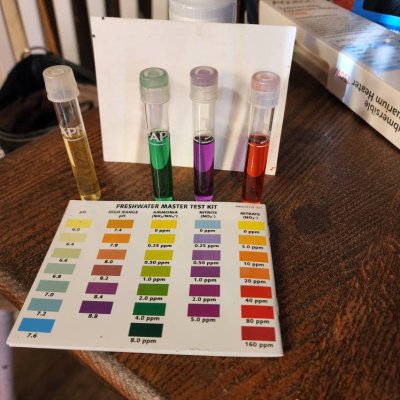bbryant573
Aquarium Advice Apprentice
Can a pH of 6.0 cause your tank to stop cycling? Tonight I am going to be ordering some crushed coral to see if it will raise my pH.
The pH in my 55g long is 6.0. I have been trying to get this one to cycle since the end of June. It's at a stand still. Everyday the ammonia and nitrites stay the same. I have one Molly fish in it.Low pH is a sign that your carbonate hardness (KH) might be low. Its not so much the pH being low that would prevent the oxidisation of ammonia, but low KH would. Is your pH that low? Your other thread has it at 7.6.
In the 55gallon long we have sand, lava rocks and plants.Are you using the same water for both tanks? Whats the pH of your tap water? To measure pH of tapwater correctly it needs to be left to stand overnight so it has chance to offgas.
If you arent seeing any movement in ammonia and your pH is that low i would get some crushed coral into the filter or a piece of cuttlefish bone in the tank somewhere as you are planning.
Weird how the 2 tanks are different. Something in the tanks is causing that difference. Do you have different rocks and substrate in the 2 tanks?
No.I am doing a fishless cycle using SeaChem Prime and SeaChem Stability. What I've noticed that although my tap water ph is about 7, once the water has been dechlorinated with SeaChem Prime and in the aquarium, when I test the aquarium water its ph is about 6. I suspect this could be due to SeaChem Prime converting the ammonia (basic) to ammonium (acidic ) thus ph goes down. Would this be a correct assumption?
Can you explain what you just said? What is dolomite powder or jbl aquador. And is potassium bicarbonate baking soda?Add some dolomite powder or some JBL aquador or a USA sourced equivalent. Potassium bicarbonate will also work.
Never allow KH to deplete. It’s important for the biofilter, nearly all aquarium plants and some inverts.
So I needed to add water to my tanks, so I got a 5 gallon bucket filled it up and added Prime to it and let it set while I tested the tanks. I want to get a reading before I added anything to both tanks.Ill add to this that 1 molly isnt going to produce enough ammonia in a 55g to cycle a tank. What is the ammonia and nitrite readings in that tank?

You need to do a water change. Probably 2 x 50% water changes a couple of hours apart. Whats been your normal water change schedule on this tank?So I needed to add water to my tanks, so I got a 5 gallon bucket filled it up and added Prime to it and let it set while I tested the tanks. I want to get a reading before I added anything to both tanks.
Here are the results from the 55g long tank that has low pH
The nitrate looks red but it really was an orange color.View attachment 323892
You need to do a water change. Probably 2 x 50% water changes a couple of hours apart. Whats been your normal water change schedule on this tank?
Did you do the water changes?
Your other thread said you was getting some more fish. Was that for this tank? Did you get the fish?
Your target should be to keep ammonia + nitrite combined no higher than 0.5ppm by changing water whenever your water parameters exceed this target. 0.5ppm combined is a level of waste that is sufficient for your cycle to establish but relatively safe for your fish.
If you see 0.5ppm ammonia and 0.0ppm nitrite (0.5ppm combined) then leave things be. If you see 0.5ppm ammonia and 0.25ppm nitrite (0.75ppm combined) then change 1/3 of the water. If you see 0.25ppm ammonia and 0.75ppm nitrite (1.0ppm combined) then change 1/2 the water. If water parameters get worse than these levels it may require multiple daily 50% water changes to maintain safe water conditions. This is more likely to happen with a fully stocked tank.
And I have been told that in this tank the one with the low pH not to do a water change that it will ruin and crash the cycle.Changing water is essential for fish in cycles. From your other thread.
Without water changes waste builds up in uncycled tanks until it gets to toxic levels. So your fish need some help from you doing water changes. Both of your tanks need water changes. Topping up following evaporation isnt the same, because evaporated water doesnt take the waste with it. There are 2 parts to a water change. Removing water and waste along with it, and refilling with clean water.
